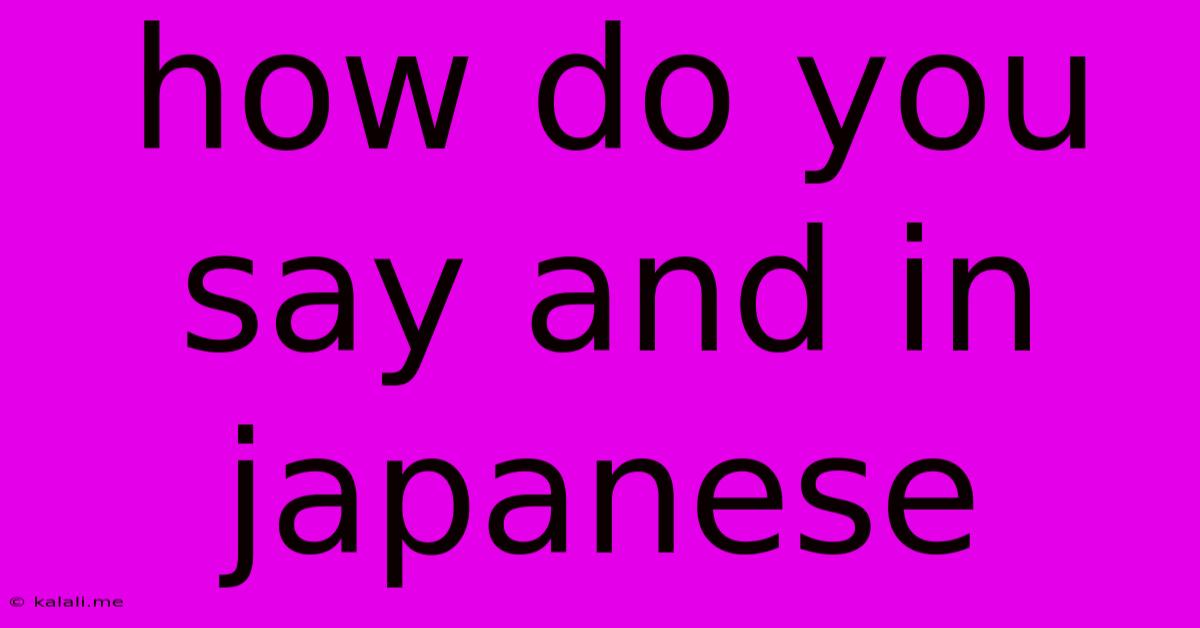How Do You Say And In Japanese
Kalali
May 19, 2025 · 3 min read

Table of Contents
How Do You Say "And" in Japanese? A Comprehensive Guide
So, you're learning Japanese and you've hit a snag: how do you say "and"? Unlike English, which uses "and" liberally, Japanese doesn't have a single, direct equivalent. The best way to translate "and" depends heavily on the context. This guide will explore the various ways to express "and" in Japanese, covering different grammatical situations and ensuring you choose the most natural and appropriate word or phrase.
This article will cover the nuances of using different conjunctions in Japanese, helping you avoid common mistakes and improve the fluency and accuracy of your Japanese sentences. We'll cover the most common ways to connect words and phrases, showing you how to choose the right connector for each context. Mastering this will significantly enhance your Japanese language skills.
Common Ways to Say "And" in Japanese
Japanese uses various particles and conjunctions to express the idea of "and," depending on what you are connecting. Here are some of the most common options:
-
と (to): This is probably the closest equivalent to "and" and is used to connect nouns, verbs, and adjectives. It's generally used to list items or actions. For example:
- リンゴとバナナ (ringo to banana) - Apple and banana
- 食べると飲みます (taberu to nomimasu) - I eat and drink
-
や (ya): This particle is similar to "to" but indicates an incomplete list. It means "and others" or "and so on." You wouldn't use it if you're listing all the items. For example:
- リンゴやバナナ (ringo ya banana) - Apples, bananas, and other fruits.
-
そして (soshite): This is a more formal way to say "and then" or "and so." It's often used to connect clauses or sentences, particularly in narrative writing or speech. For example:
- 勉強して、そして寝ます。(benkyou shite, soshite nemasu) - I studied, and then I slept.
-
それから (sorekara): Similar to "soshite," this means "and then" or "after that," implying a sequential order of events. For example:
- ご飯を食べて、それから散歩しました。(gohan o tabete, sorekara sanpo shimashita) - I ate dinner, and then I went for a walk.
-
それから (sorekara): This phrase is very similar to そして (soshite), but has slightly more of an emphasis on the timeline and sequence of events. Use it to show that one action follows directly after another.
-
加えて (kuwaete): This phrase means "in addition" or "furthermore" and is used to add extra information or points. It's more formal than "to" or "ya." For example:
- 美味しいだけでなく、加えて健康にもいいです。(oishii dake de naku, kuwaete kenkou ni mo ii desu) - It's not only delicious, but also good for your health.
Choosing the Right "And"
The key to using "and" correctly in Japanese is understanding the context. Consider the following factors:
- What are you connecting? Nouns? Verbs? Clauses? Different particles work best with different grammatical structures.
- Is the list complete or incomplete? Use "ya" for incomplete lists and "to" for complete lists.
- What is the relationship between the elements? Is it a simple addition, a sequential order, or an addition of extra information? This will determine which conjunction is most appropriate.
By carefully considering these points, you can choose the most natural and appropriate way to say "and" in Japanese, improving the flow and clarity of your sentences. Practice using these different options in various contexts to master their usage. With time and practice, selecting the correct conjunction will become second nature.
Latest Posts
Latest Posts
-
They See Us Rollin They Hatin
May 20, 2025
-
What Is My Cousin To My Son
May 20, 2025
-
Dr Who Rings Of Akhaten Speech
May 20, 2025
-
Should I Call A Taxi For Someone
May 20, 2025
-
Ceiling Rose Wiring With 3 Cables
May 20, 2025
Related Post
Thank you for visiting our website which covers about How Do You Say And In Japanese . We hope the information provided has been useful to you. Feel free to contact us if you have any questions or need further assistance. See you next time and don't miss to bookmark.